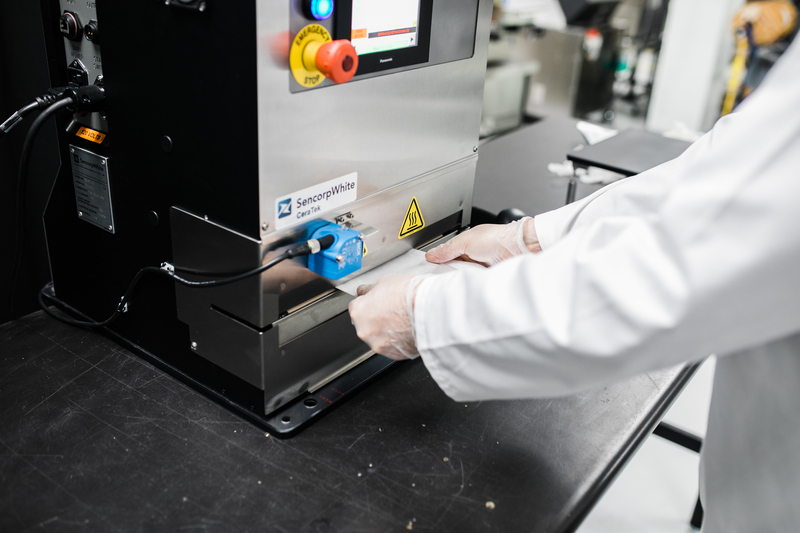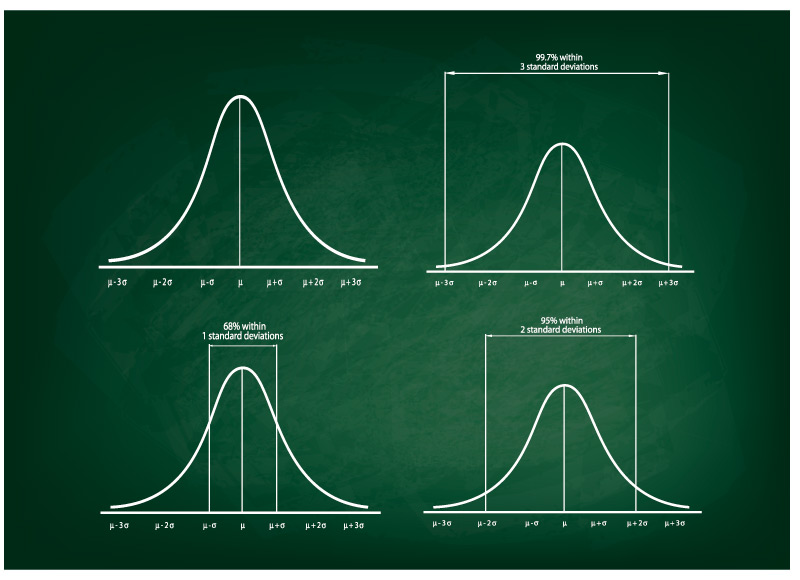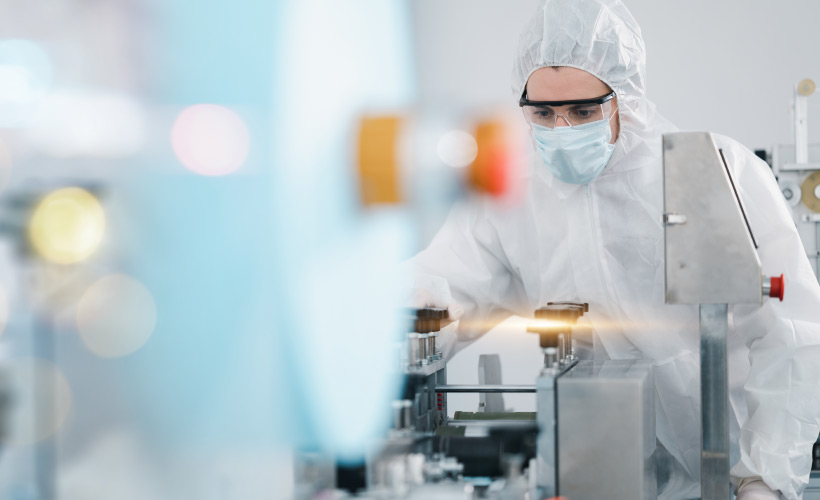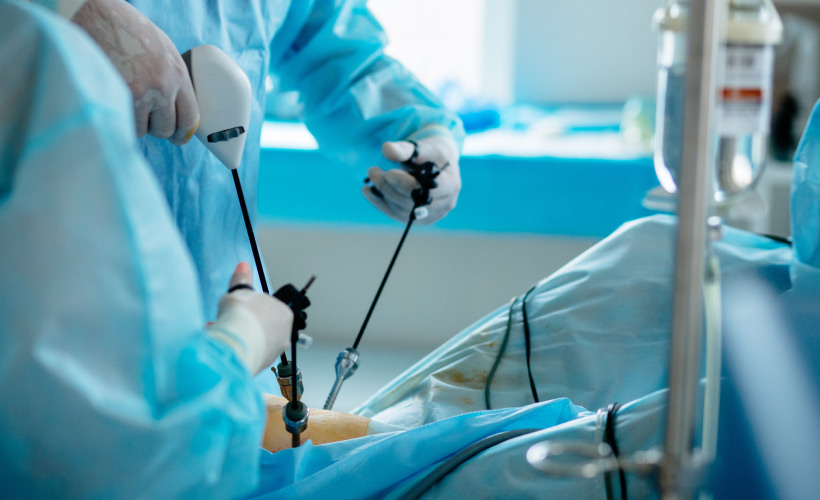Pouch Sealer Frequently Asked Questions

How does a CeraTek pouch sealer create a seal?
A CeraTek pouch sealer is designed to seal a package made from laminated or mono-layer flexible materials, and it creates a seal by applying heat and pressure to the pouch for a set amount of time. A pouch like this is created by bringing two webs of material together and sealing them on three sides, leaving the fourth side open. The product that needs to be packaged is inserted into this opening and then the pouch is inserted into the sealing machine. The CeraTek pouch sealer applies the temperature, pressure, and time required to activate a sealing adhesive which bonds the two layers of material together, creating a seal.
What are the main process variables associated with pouch sealing using a CeraTek sealer?
The main process variables associated with pouch sealing using a CeraTek sealer are time, temperature, and pressure. All three of these process variables are required to seal a pouch effectively.
How are time, pressure, and temperature controlled and monitored?
The three process variables—time, pressure, and temperature—are controlled through the CeraTek pouch sealer’s HMI. An operator can use the setup screens to program the time, temperature, and pressure based on the desired sealing process. These parameters can be changed for different materials and/or different pouch sizes.
What is the maximum temperature that a CeraTek pouch sealer can be set to?
The maximum temperature that a CeraTek pouch sealer can be set to is 400 degrees Fahrenheit for the top and bottom heat. Some pouch sealer models only use bottom heat, while others apply heat from both the top and bottom dies. If the pouch sealer has internal sensors, then the bottom heat maximum is 200 degrees Fahrenheit. Using temperatures that exceed these maximums can accelerate the wear of parts and increase maintenance costs.
What type of pouches can be sealed on CeraTek pouch sealers?
CeraTek pouch sealers can seal pouches made from a variety of different materials, including LDPE, nylon, Tyvek, foil, and many others. Our sealers are compatible with gusseted pouches, as well as with those that have headers or ones that are made from two different types of materials. If there are any question about compatibility, the experts at CeraTek are happy to test your materials and pouch designs on our equipment at our factory. The main requirement to keep in mind is that the pouch being used must be sealed on three sides. Then, the CeraTek sealer creates the fourth and final seal on the pouch.
When is Tyvek a better choice than foil?
Tyvek is a better choice than foil for products that must undergo additional sterilization processes after packaging. Tyvek is made of 100% high density polyethylene fibers, and it is manufactured to be “breathable,” yet impervious to microbes. That means Tyvek pouches can undergo sterilization processes using EtO gas, gamma radiation, electron beams, hydrogen peroxide, and steam. For example, in the case of a medical pouch made of Tyvek, the EtO gas passes through the Tyvek material, killing any contaminating microorganisms that are inside the package. Then, the pressure is relieved, as regular air is pumped back into the chamber, dispersing the EtO gas. As long as the medical pouch remains sealed, the contents are sterile. Foil is a non-breathable material, and pouches made from foil cannot be sterilized in this way.
Are CeraTek pouch sealers able to be validated?
Yes, CeraTek pouch sealers are validatable. Sealing parameters such as time, temperature, and pressure can be validated through the output ports on the side of the machine. The operator can use these ports to plug in a calibrated test instrument and retrieve the readouts of time, temperature, and pressure and confirm that the machine is functioning properly.
Are CeraTek pouch sealers ISO 11607 compliant?
Yes, CeraTek pouch sealers are ISO 11607 compliant. This compliance means that the accuracy and repeatability of the sealing process can be verified. For example, pouch sealing parameters such as time, temperature, and pressure can each be validated through their own specific output ports on the side of the machine. Each individual thermocouple has an output port for validation of the temperature readings. Likewise, there is a pressure output port and a timer output port.
Does CeraTek perform testing on pouch samples?
CeraTek has an in-house tensile tester which collects data on the strength of the seal, and we are happy to use this for testing customer samples at no cost. We can also help customers connect with others who can perform additional assessments, such as creep, burst, and dye penetration tests.
Does CeraTek offer different width sealing dies?
Yes, CeraTek offers sealing dies of different widths. The most common width is three-eighths inch, but we also offer standard one-eighth, one-fourth, one-half, and one inch sealing dies. We can also custom-make dies for requirements outside of our standard widths. Each sealing process has its own die requirements and validation parameters, so it is critical to make sure the die being used is the correct width.
When is it important to vacuum air out of a pouch prior to sealing it?
There are a few different reasons why it may be important to vacuum air out of a pouch before sealing. One of the most common reasons is to accommodate altitude changes for packaged products that are going to be shipped by air. If the pouch is sealed with too much air in it, and the altitude increases, the pouch could potentially burst. Another common reason to remove air from a pouch is to reduce its bulkiness so that it fits better into secondary packaging. CeraTek sealers can vacuum out air from a pouch through a nozzle that extends from the machine. The operator simply loads the pouch around the nozzle, initiates the cycle, and the nozzle vacuums out the air. Once the vacuum cycle is complete, the nozzle retracts and the sealing cycle begins.
How much compressed air needs to be supplied to a CeraTek pouch sealer?
For optimal pouch sealing, CeraTek recommends supplying 15 PSI above the desired pressure set point, up to a maximum of 125 PSI. For example, if the desired pressure set point is 50 PSI, we recommend supplying at least 65 PSI to the CeraTek pouch sealer. There are onboard air accumulator tanks within the CeraTek machine that reduce the risk of any pressure drops during the sealing cycle.
How is compressed air used on a CeraTek sealer?
The manufacturing facility supplies air to the CeraTek sealer’s onboard air accumulator tanks, and a pressure regulator on the machine ensures that the pressure supplied is accurate (i.e., it is not under- or overpowering). The air accumulator tanks initiate and perform the sealing cycle, driving the cylinders up and down to create the pressure applied to the seal. Incorporating these tanks into the sealer’s design helps mitigate the risk of fluctuation in the air supply. For instance, if the manufacturing facility has multiple machines on the same airline, the pressure flow across that line could vary. The CeraTek sealer’s air accumulator tanks significantly mitigate that risk.




